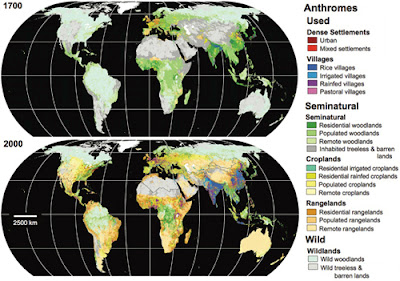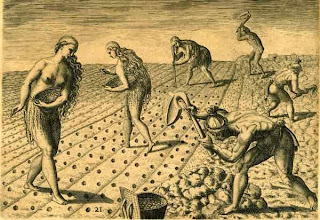Over my last two posts I have investigated
the topic of anthropogenic transformation of the terrestrial biosphere. With so
much information at hand I want to make sure that I wrap up this topic neatly
and so this post will serve hopefully as a summary.
We have seen how humans alter ecosystems
both by introducing novel processes (e.g. use of synthetic nitrogen fertilisers
to increase productivity) and by altering pre-existing ones (e.g. genetically
modifying crops to become resistant to herbicides and pesticides).
However, not all anthromes and biomes are
affected equally by humans, as Ellis (2011) explores. It is reported that
densely settled anthromes, such as towns and cities and cropland anthromes, incorporate the widest variety of novel ecosystem forms and processes and so
are the most intensively transformed (Ellis, 2011). In these places
pre-existing ecological patterns and processes have been shifted outside their
natural range. Seminatural anthromes (such as hedgerows!) are transformed at
lower levels of intensity. As you may have noticed from my previous posts, I
have a great interest in seminatural anthromes. I think in this context their
ecological importance is made really clear, and their role as refuges for
non-agricultural species in increasingly transformed cropland anthromes is brought to light.
So the big question: Have human systems
irreversibly transformed the terrestrial biosphere?
Well, if we take the most conservative
view, then nearly one-third of the terrestrial biosphere has been transformed
into anthromes in which pre-exisiting ecosystem forms and processes have been
shifted beyond their natural range and so may now be considered to be novel
(Ellis, 2011).
Ellis (2011) concludes that the terrestrial
biosphere is now predominantly anthropogenic. It is believed that it has been
this way since the latter half of the twentieth century, when the transition
from a terrestrial biosphere controlled by natural and biophysical
processes to one that is controlled by human systems, was made. The sad news is
(and I find this quite remarkable) if human populations were to disappear now,
the global geological record of anthropogenic transformation of the terrestrial
biosphere would persist – in other words: the changes are irreversible.
I really do find this exceptional and maybe that's why I have spent so much time on this topic. To
consider the human system as something so powerful that is has strained the
geological record is quite extraordinary. The news at the moment is dominated
by stories of the flood risk that faces large parts of the UK, and the freezing
‘Arctic’ temperatures that North America is currently experiencing. These are
reminders of the huge hold nature still has over us, and so as our ability to
engineer the ecosystems increases exponentially, I think it’s important that we
don’t forget the power of nature.
 |
| Is it really possible that human systems have greater control over ecosystem forms and processes than natural and biophysical processes? Source: The Telegraph |










